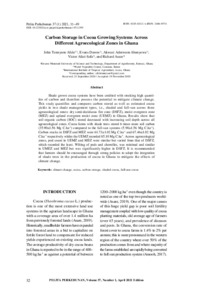| dc.contributor.author | Afele, J.T. |
| dc.contributor.author | Dawoe, E. |
| dc.contributor.author | Abunyewa, A.A. |
| dc.contributor.author | Afari-Sefa, V. |
| dc.contributor.author | Asare, R. |
| dc.date.accessioned | 2021-07-01T15:09:14Z |
| dc.date.available | 2021-07-01T15:09:14Z |
| dc.date.issued | 2021 |
| dc.identifier.citation | Afele, J.T., Dawoe, E., Abunyewa, A.A., Afari-Sefa, V. & Asare, R. (2021). Carbon storage in cocoa growing systems across different agroecological zones in Ghana. Pelita Perkebunan, 37(1), 32-49. |
| dc.identifier.issn | 0215-0212 |
| dc.identifier.uri | https://hdl.handle.net/20.500.12478/7154 |
| dc.description.abstract | Shade grown cocoa systems have been credited with stocking high quantities of carbon and therefore possess the potential to mitigate climate change and help achieve targets of the United Nations Collaborative Program on Reduced Emissions from Deforestation and Forest Degradation (REDD+). This study quantifies and compares carbon stored as well as estimated cocoa yields in two shade management types (i.e., shaded and full sun) across three agroecological zones: Dry Semi-Deciduous Fire Zone (DSFZ), Moist Evergreen Zone (MEZ) and Upland Evergreen Moist Zone (UEMZ) in Ghana. Results show that Soil organic carbon (SOC) stored decreased with increasing soil depth across all agroecological zones. Cocoa farms with shade trees stored 6 times more soil carbon (35.90±1.56 Mg C ha-1) compared to the full sun systems (5.98±1.56 Mg C ha-1). Carbon stocks in the DSFZ and the MEZ were 61.73±1.02 Mg C/ha and 67.46±1.02 Mg C ha-1 respectively whiles the UEMZ recorded 85.10 Mg C ha-1. Across agroecological zones, pod count in the UEMZ and the MEZ were similar but varied from that of the DSFZ, which recorded the least. Wilting of pods and cherrelles, was minimal and similar in the UMEZ and the MEZ but was significantly higher in the DSFZ. It is recommended that farmers should be encouraged through strong policies to adopt the integration of shade trees in the production of cocoa in Ghana to mitigate the effects of climate change. |
| dc.description.sponsorship | International Institute of Tropical Agriculture |
| dc.format.extent | 32-49 |
| dc.language.iso | en |
| dc.subject | Climate Change |
| dc.subject | Cocoa |
| dc.subject | Carbon |
| dc.subject | Storage |
| dc.subject | Agroecology |
| dc.title | Carbon storage in cocoa growing systems across different agroecological zones in Ghana |
| dc.type | Journal Article |
| cg.contributor.affiliation | Kwame Nkrumah University of Science and Technology |
| cg.contributor.affiliation | World Vegetable Center |
| cg.contributor.affiliation | International Institute of Tropical Agriculture |
| cg.coverage.region | Africa |
| cg.coverage.region | West Africa |
| cg.coverage.country | Ghana |
| cg.coverage.hub | Headquarters and Western Africa Hub |
| cg.researchtheme | Natural Resource Management |
| cg.identifier.bibtexciteid | AFELE:2021 |
| cg.authorship.types | CGIAR and developing country institute |
| cg.iitasubject | Agronomy |
| cg.iitasubject | Climate Change |
| cg.iitasubject | Cocoa |
| cg.iitasubject | Natural Resource Management |
| cg.iitasubject | Plant Breeding |
| cg.iitasubject | Plant Production |
| cg.iitasubject | Socioeconomy |
| cg.journal | Pelita Perkebunan |
| cg.notes | Open Access Article; Published online: 01 Apr 2021 |
| cg.accessibilitystatus | Open Access |
| cg.reviewstatus | Peer Review |
| cg.usagerightslicense | Creative Commons Attribution 4.0 (CC BY 0.0) |
| cg.targetaudience | Scientists |
| cg.identifier.doi | https://dx.doi.org/10.22302/iccri.jur.pelitaperkebunan.v37i1.395 |
| cg.iitaauthor.identifier | Richard Asare: 0000-0001-6798-7821 |
| cg.futureupdate.required | No |
| cg.identifier.issue | 1 |
| cg.identifier.volume | 37 |

